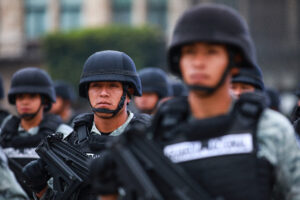By Clay Boggs*
A train carrying around 250 migrants, most of them from Central America, derailed in southern Mexico on Sunday, August 25, killing at least nine and injuring at least 18. The bodies of six deceased migrants were flown back to Honduras, their native country, on Tuesday, August 27.
Via Twitter, Mexican President Enrique Peña Nieto expressed his “condolences to the family members of those who lost their lives in this accident” and assured them that the Foreign Ministry would provide them with the “necessary information and support.”
But the president’s words ring hollow. While what happened was a tragic accident whose causes are yet to be determined, victims’ families know that the Mexican government has done very little to prevent the tragedies suffered every day by migrants in transit in the country. For several years, the government has known about the severe dangers that migrants face in their journey across Mexico. Countless news articles and reports from migrant shelters have chronicled the experience of Central American migrants who ride across Mexico on top of the train that they call La Bestia (the Beast), and human rights organizations from across the world have called attention to the situation of migrants in transit through Mexico, calling it, correctly, a “humanitarian tragedy.”
The scale and nature of abuses against migrants are chilling. Migrants are frequently subject to rape, kidnapping, extortion, and murder. Female migrants have told human rights defenders that they began to take birth control pills before crossing Mexico, because they knew it was very likely that they would be raped. In its 2011 report, Mexico’s National Human Rights Commission (Comisión Nacional de Derechos Humanos, CNDH) estimated that there had been over 11,000 kidnappings of migrants in transit through Mexico in a six month period. Migrants have been kidnapped en masse, with criminal gangs in some cases stopping trains to remove hundreds of migrants at a time and take them to “safe” houses where they are frequently beaten, poorly fed, and subjected to numerous other abuses until the criminals can collect ransom money from the migrants’ families. Those who cannot pay are often brutally tortured and sometimes killed.
Mexico’s government has promised to address this situation. After the August 2010 massacre of 72 migrants in San Fernando, Tamaulipas that shocked the world, then-president Felipe Calderón announced a five-point plan to protect migrants in transit. In 2011, the Mexican congress passed new legislation to regulate migration in Mexico that promised to better protect migrants.
But in spite of the government’s discourse, the situation does not appear to have improved. Migrant shelters across Mexico continue to denounce frequent abuses against migrants. Too often, staff members at migrant shelters, which play a critical role in defending migrant rights, have been the victims of harassment by both authorities and criminal groups. A shelter for minors in Tapachula, Chiapas, was shut down this month because of security concerns. Even more concerning is the fact that in many cases, Mexican authorities are complicit or directly involved in crimes against migrants.
Nor has the government done enough to search for the thousands of migrants that have disappeared across Mexico in recent years, or to identify the remains of migrants whose bodies are found. For example, three years after the massacre at San Fernando, several of the bodies remain unidentified. Fortunately, there does seem to be some movement in this area. A broad range of actors—Central American groups made up of family members of disappeared migrants, Mexican civil society organizations, the Mexican Attorney General’s Office, and the Argentine Forensic Anthropology Team—recently signed an agreement to create a Commission of Forensic Experts that will identify remains from the San Fernando massacre, other mass graves in San Fernando, and remains found in Cadereyta, Nuevo Leon (it is believed that many of the bodies recovered in those graves were migrants). If fully supported and sufficiently funded, this commission could help provide closure to relatives of disappeared migrants and help to ensure that atrocities such as these massacres do not happen again.
This tragic train accident underscores the vulnerability of Central American migrants in transit and the urgent need for the Mexican government to do more to protect them. In the wake of the recent tragedy, the Mexican government should take clear steps to better protect migrants in transit, such as:
- Investigating and prosecuting corrupt officials from Mexico’s National Migration Institute (Instituto Nacional de Migración, INM); federal, state, and municipal police forces; and members of the military who have been involved in human rights violations and criminal acts against migrants.
- Adopting specific policies to address the involvement of criminal organizations in the kidnapping of migrants.
- Guaranteeing that staff at shelters and other defenders of migrants’ human rights receive effective protection and that investigations are carried out to prosecute and sanction those responsible for threats and attacks against them.
- Fully supporting the work of the new Forensic Commission and ensuring that the commission has the necessary resources to carry out its work.
*Clay Boggs is a program officer at WOLA.
(Photo by Ireneo Mujica)


